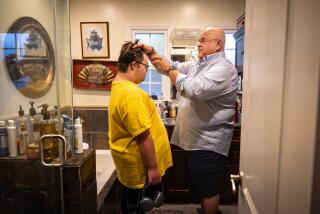New O.C. Family Center Adds to a California Trend
For years, there hasnât been much fun for youngsters in a rough-and-tumble neighborhood just south of downtown Santa Ana, where a state-of-the-art community center is now taking shape.
Excitement is unmistakable as residents wait for this weekâs dedication of the complex, built mostly with private funds. Parents and their children have already lined up to enroll in programs. A homework clinic for 150 students is full.
âWe need something like this in our neighborhood,â says nearby resident Julia Oliva. âIt will get kids off the streets. A lot of the time, they are in trouble because they have nothing better to do.â
With the dedication set for Thursday, then opening Monday, the center includes something for every age: a licensed preschool stocked with wooden toys; a 34-station computer lab; a youth room with a deejay booth; English classes and seminars in âfinancial literacyâ; and a snack bar including donated food.
The $3.5-million complex on Chestnut Avenue, a former warehouse, is the latest achievement of Kidworks, a nonprofit group founded in 1993 and intended to help families in central Santa Ana. It is named for Kidworks booster and Newport Beach developer Dan Donahue, who died in 2002. His friends raised $1 million for what became the Donahue Center.
Neighbors are âbeyond excited,â said Roman Reyna, president of the Casa Bonita Neighborhood Assn. âThey are elated.â
The new center, he said, âgives a strong, powerful message that we are taking ownership, erasing the negative stuff and injecting positive aspects into the neighborhood.â
Residents of the nearby Casa Bonita and Bella Vista neighborhoods hope the center will help youngsters stay in a school in a city with a high dropout rate, and help their parents -- most of them immigrants -- adjust to life in the United States.
Itâs not the only family resource center opening in Orange County. In January, the Tiger Woods Center is set to open in west Anaheim, offering golf and computer classes, among other services, in a 35,000-square-foot complex.
âEveryone is very interested in this because of the advantages this will create for youth in West Anaheim,â said Esther Wallace, chairwoman of the West Anaheim Neighborhood Development Council. âPeople say children need a place to go after school that is safe and also where there is something constructive to do.â
Centers like these are increasingly common in working-class and immigrant neighborhoods across Southern California.
Facilities like these -- often known as family resource centers, with offerings for adults as well as children -- have become so prevalent in recent years that the Sacramento-based California Family Resource Assn. was formed to serve as an information source and to lobby for their needs.
The associationâs board president, Susan Kaplan, estimates that there are 2,500 such centers in California, five times the number of five years ago. The trend, she said, stems from the swelling ranks of new immigrants and their needs, as well as cuts in government services.
The term âfamily resource centerâ is a loose one, said UCLA social welfare professor Todd Franke, who noted that there were no rules about what such a center must offer.
Many newer programs developed from existing ones that simply expanded their missions, Kaplan said.
For example, the South Bay Counseling Center in El Segundo, which began offering psychological help in 1973, gradually added other services -- such as job-finding help, housing assistance and child-care referrals -- over the last 10 years.
Other nonprofit groups have refurbished buildings and added to their offerings. The Delhi Community Center moved into a modern facility in Santa Ana three years ago to offer HIV services, English classes and cultural programs.
With fewer resources available from many private and government sources, these centers âgive communities a better bang for their buck,â said Jorja Leap, a professor of social welfare at UCLA. âThe idea isnât new. Itâs just being used more. Families can just go to one place. Thereâs a greater chance of success.â
The resource center concept caught on when, in 1993, the stateâs Healthy Start Initiative put family centers with medical, dental and mental health services on school campuses.
When Larry Acosta, a church pastor, founded Kidworks that same year, he was not focused as much on the concept of a center as on Santa Ana teens specifically. He wanted to channel recent immigrants away from the negative pressures in their neighborhoods, so he recruited college students to conduct Bible studies with them.
Acosta, now a Kidworks board member, then opened a homework help center on Santa Anaâs Townsend Street in 1996. Programs expanded at the center and at a second site on Myrtle Street, where a preschool class opened in 1999. Homework help and youth groups followed. There was always a waiting list because each of the sites was so small.
The new Santa Ana center is in a federal empowerment zone, a 4-square-mile area where tax incentives and grants are available. The center received $628,000 in federal money, half loan and half grant.
Kidworks parlayed private donations to win support from other wealthy benefactors. It collected a total of about $3.5 million to buy and refurbish the building, said Kidworks President Ava Steaffens.
Residents who use the center will pay a monthly fee of $5 each, with a maximum of $20 per family, to use all services.
Spanish speaker Alejandra Hernandez, who has been in the United States three months, managed to get her 5-year-old daughter, Yaretzy, into the program.
âIt was vital for me because I donât speak English,â said the mother, who plans to take English and computer classes at the center. âI canât even help my daughter with her homework, and sheâs in kindergarten.â
More to Read
Sign up for Essential California
The most important California stories and recommendations in your inbox every morning.
You may occasionally receive promotional content from the Los Angeles Times.










